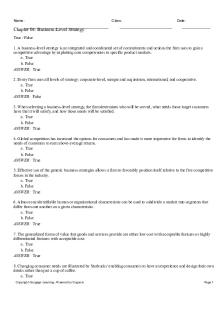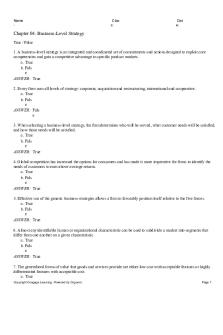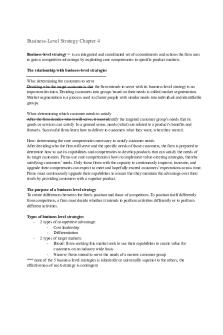Tim hortons - Business Level Strategy (DAP) PDF

| Title | Tim hortons - Business Level Strategy (DAP) |
|---|---|
| Author | Charlene Zheng |
| Course | Topics In Business Iii - Busi Ethcs Ldshp |
| Institution | The University of British Columbia |
| Pages | 2 |
| File Size | 144.5 KB |
| File Type | |
| Total Downloads | 111 |
| Total Views | 148 |
Summary
Tim hortons - Business Level Strategy (DAP)...
Description
Diploma In Accounting Program – Strategic Management (BUSI 493) – Business Level Strategy Product/Service Strategy What’s offered
Pricing Strategy Price level high/ low
Promotional Strategy Message to market
Place (Distribution/Chanel) Strategy
Target Market Strategy
How is the product/service better or different?
What is the unit price of the product / service?
What is the key message to customers?
Where and how do customers purchase & obtain the product / service?
Who is the typical customer? What are his/her wants & needs?
Iconic products : double double/ timbits
Value brand Main competitor: mcdonalds/subway/café Affordable
Canadian brand -> hard to expand to other countries Culture Promotes hockey sponsorship
Drive-through (big impact)
Blue collar
Low price -> meets the need of the target market
Roll up to win Community Sponsor kids sports Canadian troops
Diverse access Restaurant/kiosk/deliver y
Coffee / donuts/ breakfast / lunch (sandwich/ soup) Expanding menu Healthier fast food ? 24 hr service Consistency (same taste in different location)
Coverage in Canada
Affordability Hockey parents Small town Canada Seniors Geography (urban vs rural) Life style/democratics
“Always Fresh!” slogan for coffee
Diploma In Accounting Program – Strategic Management (BUSI 493) – Business Level Strategy a) Briefly describe TIM HORTONS' business level strategy. Commitment to food and beverage quality, planet earth, people, and communities. Tim Horton’s has a very strong Canadian brand image. Their vision is to provide excellent quality food and beverages to their customers, to support healthy planet, and to continuously give back to the people and communities. Their mission is to strive to be quality leader in everything they do. Tim Horton’s is committed to provide consistent and remarkable product quality. Their price is on the low level compared to McDonalds, Subway or any other traditional café. Their target markets are working class, families, and young people in middle- or low-income class. As their market size grow, they also expanded their range of products to suit customer’s tastes. Tim horton’s also supported and sponsored kids, troops, hockey, and people who need help with, which meet their vision to give back to communities. And lastly to help reducing waste and protecting the planet, they carefully designed and chose their packaging by using more environmentally friendly materials. In my opinion, their greatest strength of their business strategy is the message it signals to the public that the company not only want to do the best in quality of food and services, but also can create a better environment for everyone and to support people who need help. This conveys positive corporate image to the market. On the opposite, because of its iconic Canadian brand image for middle and low class, it might face difficulties in business expansion in urban and in other countries. Issues?...
Similar Free PDFs

Tim hortons 1&2
- 5 Pages

Tim Hortons Report
- 9 Pages

04-Tim Hortons-Case Study
- 2 Pages

3 - Business level strategy
- 3 Pages

Business Level strategy
- 14 Pages

Business level strategy Samsung
- 5 Pages

Tim Hortons Case - Grade: B
- 4 Pages

CH 4 - Business Level Strategy
- 9 Pages

Chapter 04 Business Level Strategy
- 21 Pages

Chapter 04 Business Level Strategy
- 25 Pages
Popular Institutions
- Tinajero National High School - Annex
- Politeknik Caltex Riau
- Yokohama City University
- SGT University
- University of Al-Qadisiyah
- Divine Word College of Vigan
- Techniek College Rotterdam
- Universidade de Santiago
- Universiti Teknologi MARA Cawangan Johor Kampus Pasir Gudang
- Poltekkes Kemenkes Yogyakarta
- Baguio City National High School
- Colegio san marcos
- preparatoria uno
- Centro de Bachillerato Tecnológico Industrial y de Servicios No. 107
- Dalian Maritime University
- Quang Trung Secondary School
- Colegio Tecnológico en Informática
- Corporación Regional de Educación Superior
- Grupo CEDVA
- Dar Al Uloom University
- Centro de Estudios Preuniversitarios de la Universidad Nacional de Ingeniería
- 上智大学
- Aakash International School, Nuna Majara
- San Felipe Neri Catholic School
- Kang Chiao International School - New Taipei City
- Misamis Occidental National High School
- Institución Educativa Escuela Normal Juan Ladrilleros
- Kolehiyo ng Pantukan
- Batanes State College
- Instituto Continental
- Sekolah Menengah Kejuruan Kesehatan Kaltara (Tarakan)
- Colegio de La Inmaculada Concepcion - Cebu





